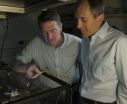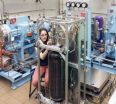(Press-News.org) Researchers from the National Institute of Standards and Technology (NIST) and California Institute of Technology (Caltech) have demonstrated a new design for an atomic clock that is based on a chip-scale frequency comb, or a microcomb.
The microcomb clock, featured on the cover of the inaugural issue of the new journal Optica,* is the first demonstration of all-optical control of the microcomb, and its accurate conversion of optical frequencies to lower microwave frequencies. (Optical frequencies are too high to count;microwave frequencies can be counted with electronics.)
The new clock architecture might eventually be used to make portable tools for calibrating frequencies of advanced telecommunications systems or providing microwave signals to boost stability and resolution in radar, navigation and scientific instruments. The technology also has potential to combine good timekeeping precision with very small size. The comb clock might be a component of future "NIST on a chip" technologies offering multiple measurement methods and standards in a portable form.
"The microcomb clock is one way we might get precision frequency metrology tools out of the lab and into real-world settings," NIST physicist Scott Diddams says.
Frequency combs produce precisely defined colors, or frequencies, of light that are evenly spaced throughout the comb's range. (The name comes from the spectrum's resemblance to the teeth of a pocket comb.) The original combs required relatively large lasers that produced rapid, extremely short pulses of light, but more recently NIST and other laboratories have developed much smaller microcombs.**
A microcomb generates its set of frequencies from light that gets trapped in the periphery of a tiny silica glass disk, looping around and around the perimeter. These combs can be astonishingly stable. NIST has an ongoing collaboration in this area with Caltech researchers, who made the 2-millimeter-wide silica disk that generates the frequency comb for the new clock.
The new microcomb clock uses a laser to excite the Caltech disk to generate a frequency comb, broadens the spectrum using nonlinear fiber, and stabilizes two comb teeth (individual frequencies) to energy transitions in rubidium atoms that "tick" at optical frequencies. (Conventional rubidium atomic clocks operate at much lower microwave frequencies.) The comb converts these optical frequency ticks to the microwave domain.
Thanks to the gear-like properties of the disk and the comb, the output is also 100 times more stable than the intrinsic ticking of the rubidium atoms. According to Diddams. "A simple analogy is that of a mechanical clock: The rubidium atoms provide stable oscillations—a pendulum—and the microcomb is like a set of gears that synthesizes optical and microwave frequencies."
The center of the comb spectrum is locked to an infrared laser operating at 1560 nanometers, a wavelength used in telecommunications.
NIST researchers have not yet systematically analyzed the microcomb clock's precision. The prototype uses a tabletop-sized rubidium reference. The scientists expect to reduce the instrument size by switching to a miniature container of atoms like that used in NIST's original chip-scale atomic clock.*** Scientists also hope to find a more stable atomic reference.
The microcomb chip was made by use of conventional semiconductor fabrication techniques and, therefore, could be mass produced and integrated with other chip-scale components such as lasers and atomic references. NIST researchers expect that, with further research, the microcomb clock architecture can achieve substantially better performance in the future.
INFORMATION:
The research is supported in part by the Defense Advanced Research Projects Agency and National Aeronautics and Space Administration.
*S.B. Papp, K. Beha, P. Del'haye, F. Quinlan, H. Lee, K.J. Vahala and S.A. Diddams. A microresonator frequency comb optical clock. Optica 1, 10-14. July 22, 2014.
**See 2011 NIST Tech Beat article, "Future 'Comb on a Chip': NIST's Compact Frequency Comb Could Go Places," at http://www.nist.gov/pml/div688/comb-102511.cfm.
***See 2013 NIST Tech Beat article, "NIST Scientists Win 2014 Rank Prizes for Chip-Scale Atomic Clock," at http://www.nist.gov/pml/div688/rank-052813.cfm, and additional links in the footnotes.
'Comb on a chip' powers new NIST/Caltech atomic clock design
2014-07-22
ELSE PRESS RELEASES FROM THIS DATE:
Mount Sinai scientists and international team shed new light on schizophrenia
2014-07-22
NEW YORK, NY -- As part of a multinational, collaborative effort, researchers from the Icahn School of Medicine at Mount Sinai have helped identify over 100 locations in the human genome associated with the risk of developing schizophrenia, in the largest genomic study published on any psychiatric disorder to date, conducted with 80,000 people. The findings, published online in Nature, point to biological mechanisms and pathways that may underlie schizophrenia, and could lead to new approaches to treating the disorder, which has seen little innovation in drug development ...
P90X? Why consumers choose high-effort products
2014-07-22
Stuck in traffic? On hold for what seems like an eternity? Consumers often face situations that undermine their feelings of control. According to a new study in the Journal of Consumer Research, when a person's sense of control is threatened, they are more likely to seek out products that require hard work.
"Intuitively, it would seem that feeling a loss of control might cause consumers to seek out a product that does NOT require them to exert very much effort. But we find that consumers actually look to products that require hard work to restore their belief that they ...
Fill 'er up: NIST develops prototype meter test for hydrogen refueling stations
2014-07-22
To support the fair sale of gaseous hydrogen as a vehicle fuel, researchers at the National Institute of Standards and Technology (NIST) have developed a prototype field test standard to test the accuracy of hydrogen fuel dispensers. Once the standard is field tested, it will serve as a model for constructing similar devices for state weights and measures inspectors to use.
Three automakers plan to begin selling hydrogen-fueled vehicles to consumers in 2015. The state of California has opened nine refueling stations and is funding the construction of an additional 28 ...
Overdoing it: Multiple perspectives confuse consumers
2014-07-22
Television commercials for luxury vehicles pack a lot in their 30-second running times: the camera offers quick shots of the soft leather upholstery, the shiny colors, the state-of-the-art entertainment system, and the four-wheel drive. But these multiple angles and shifting perspectives have a negative impact on consumer evaluation of products, according to a new study from a Tel Aviv University researcher.
TAU's Dr. Yael Steinhart and her collaborators Yuwei Jiang of Hong Kong Polytechnic University, Rashmi Adaval of Hong Kong University of Science and Technology, and ...
Why do challenging tasks make consumers believe drugs wear off faster?
2014-07-22
Imagine that you have a cup of coffee and sit down to read People magazine. How long do you think the energy boost will last before you reach for another cup? Would you need more caffeine if you tried to read War and Peace? A new study in the Journal of Consumer Research finds that consumers wrongly believe that pharmacological products such as coffee and aspirin lose their effectiveness when they engage in more strenuous activities.
"People make assumptions about how long it takes for products to wear off. For example, they know that cars burn gasoline more quickly ...
Empathy or justice: What makes consumers donate more to charity?
2014-07-22
Have you ever received a request for help and wondered how deserving the recipients are of your donation? This way of thinking may seem inconsistent with your moral values, especially if you consider yourself an otherwise compassionate and empathic person. A new study in the Journal of Consumer Research suggests that moral identity decreases donations when recipients are deemed to be responsible for their plight.
"Our research examines how moral values of empathy and justice have distinct influences on people when they are asked to make donations benefiting others whose ...
I'll have what he's having? How consumers make choices about new products
2014-07-22
Have you found yourself at a fancy restaurant trying to impress new friends or in a foreign country and unsure of what to order? Not wanting to appear foolish, you just go along with everyone else. According to a new study in the Journal of Consumer Research, we're more likely to copy other people's choices when we lack social acceptance or enough information to make an informed decision.
"We suggest that when someone is deciding between options for which their preferences are not well formed, observing the choice of another consumer makes the option chosen by the other ...
Quantum leap in lasers at Dartmouth brightens future for quantum computing
2014-07-22
Dartmouth scientists and their colleagues have devised a breakthrough laser that uses a single artificial atom to generate and emit particles of light. The laser may play a crucial role in the development of quantum computers, which are predicted to eventually outperform today's most powerful supercomputers.
The study appears in the journal Physical Review B.
The new laser is the first to rely exclusively on superconducting electron pairs. "The fact that we use only superconducting pairs is what makes our work so significant," says Alex Rimberg, a professor of physics ...
Clients of BMC's violence interventional advocacy program find experience supportive
2014-07-22
(Boston)-- Researchers from Boston University School of Medicine (BUSM) and Boston Medical Center (BMC) have found that participants who received care through BMC's Violence Intervention Advocacy Program (VIAP)--an interventional program targeting the physical, mental, emotional and social needs of violently injured youths—were less likely to retaliate for their injuries and experienced life changing behaviors through connections to caring, steady, supportive adults who helped them feel trust and hope. These findings are reported in the journal Academic Emergency Medicine. ...
How children categorize living things
2014-07-22
How would a child respond to this question? Would his or her list be full of relatives, animals from movies and books, or perhaps neighborhood pets? Would the poppies blooming on the front steps make the list or the oak tree towering over the backyard?
How might the animals children name compare to those named by children raised in a different cultural or language background or in a community that offers more direct contact with the natural world?
In a study conducted by Andrea Taverna of the Consejo Nacional de Investigaciones Científicas y Técnicas (Formosa, Argentina) ...

